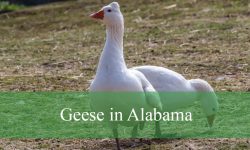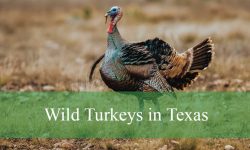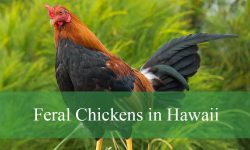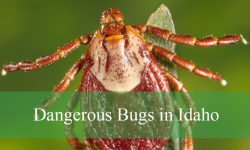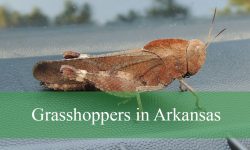New Hampshire is a wonderful place to watch hawks gliding through open skies or perched high above quiet forests. The state’s mix of coastal wetlands, farmland, and mountain ridges provides ideal habitats for a wide range of raptors. From the calm shores of Great Bay to the peaks of the White Mountains, hawks can be seen almost anywhere if you know where to look.
Each species has its own story and character. The Red-tailed Hawk often soars above fields in wide circles, while the Cooper’s Hawk moves quickly through dense woods in pursuit of songbirds. During spring and fall, thousands of hawks pass overhead during migration, offering breathtaking views for birdwatchers across the state.
These remarkable birds are more than just skilled hunters. They are vital to the natural balance, controlling rodent populations and keeping ecosystems healthy. Observing them in their native habitats reveals both the beauty and power that make New Hampshire’s skies so alive with movement.
Different Types of Hawks Found in New Hampshire
Red-tailed Hawk (Buteo jamaicensis)
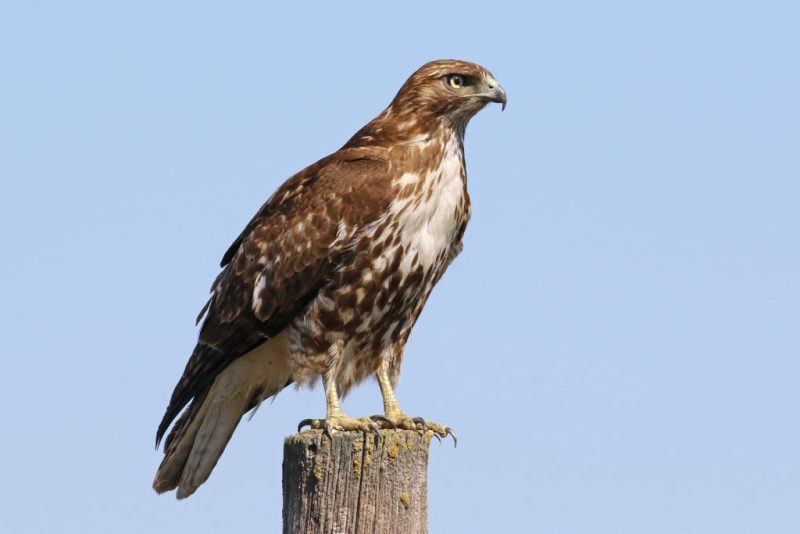
The Red-tailed Hawk is the most widespread and easily recognized raptor in New Hampshire. This large hawk measures between 18 to 26 inches in length with a wingspan of up to 56 inches, giving it a commanding presence as it soars effortlessly above fields and forests. Adults display a creamy white underside with a dark belly band and a characteristic brick-red tail that gleams under sunlight. Juveniles lack the red tail, instead showing narrow brown bands until they mature.
These hawks are powerful hunters equipped with exceptional vision, enabling them to detect movement from hundreds of feet away. Their broad wings and wide tail help them glide and circle in open air while scanning for prey below. Their cry — a harsh, descending scream — is often used in movies to represent all eagles and hawks, adding to their fame.
In terms of behavior, Red-tailed Hawks are territorial and often form lifelong pairs. They hunt mainly during the day, perching on high poles, dead trees, or cliffs to spot rodents, rabbits, or even snakes. During winter, they may rely heavily on roadside hunting as small mammals emerge from snow tunnels.
Within New Hampshire, Red-tailed Hawks are year-round residents and can be found across all regions, from the agricultural lowlands of the Merrimack Valley to the mixed forests of the White Mountains. They thrive in open spaces with nearby woodlots, making farmlands and forest edges ideal habitats for nesting and hunting.
Cooper’s Hawk (Accipiter cooperii)
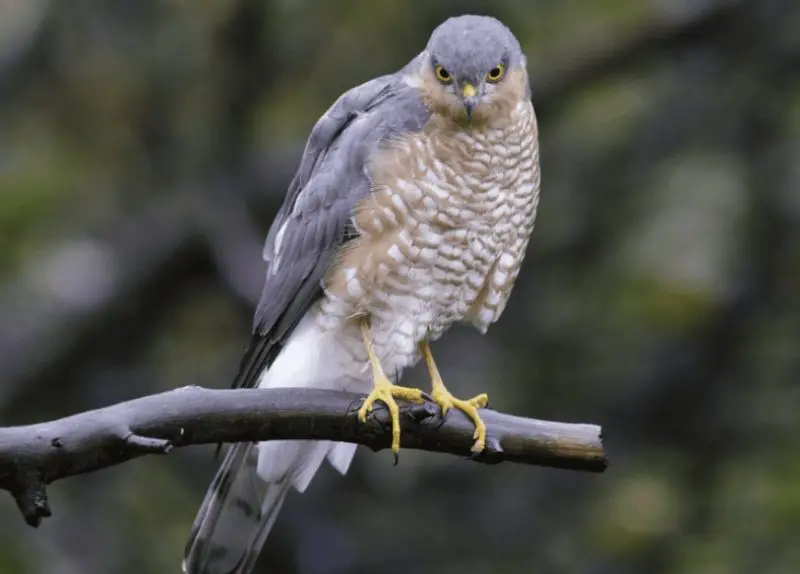
The Cooper’s Hawk is a medium-sized bird of prey measuring 14 to 20 inches in length, with a wingspan ranging from 24 to 36 inches. Adults exhibit slate-blue upperparts, red-orange horizontal barring on the chest, and a long, rounded tail with dark bands. Juveniles are brown with vertical streaks on the underparts. Their short wings and long tail make them highly maneuverable, perfectly adapted for flying through dense woods at high speed.
These hawks are adept ambush predators, specializing in capturing small to medium-sized birds such as robins, jays, and mourning doves. They often surprise their prey by weaving swiftly through trees and shrubs before striking with precision. Cooper’s Hawks are stealthy and patient, frequently perching motionless for long periods before launching into sudden pursuit.
They are fairly adaptable and have learned to coexist with humans, often drawn to suburban areas where bird feeders attract potential prey. This has led to more frequent backyard sightings, especially during the fall and winter months. Despite their stealth, their appearance near feeders can cause panic among smaller birds — a telltale sign of their presence.
In New Hampshire, Cooper’s Hawks are common in southern and central regions, including Manchester, Concord, and Nashua, where mixed woodlands meet residential neighborhoods. While they can be found year-round, some individuals migrate southward during severe winters, returning in early spring to reclaim nesting territories.
Sharp-shinned Hawk (Accipiter striatus)
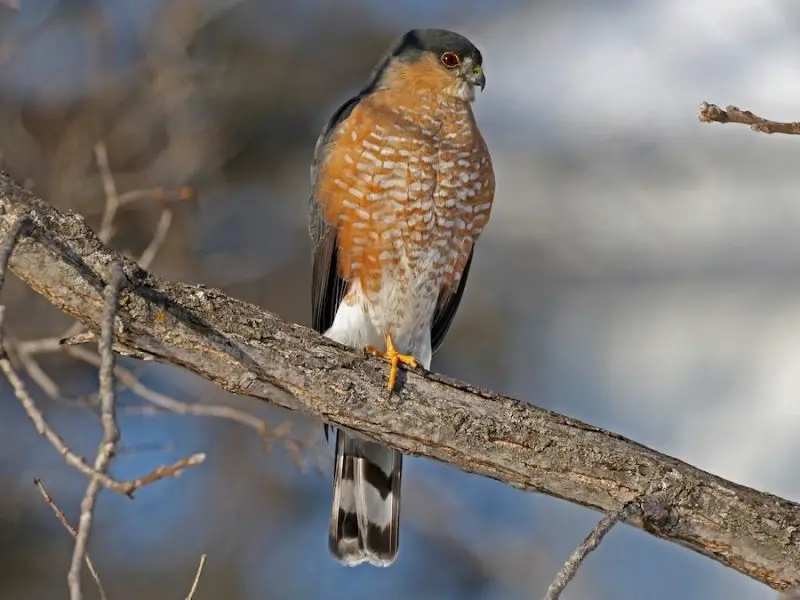
The Sharp-shinned Hawk is the smallest hawk species in New Hampshire, measuring 9 to 13 inches long with a wingspan of about 16 to 22 inches. Males are noticeably smaller than females — a characteristic trait of accipiters. Adults show bluish-gray backs, reddish-orange bars across the chest, and a square-tipped tail, while juveniles are streaked with brown and have yellow eyes that gradually darken with age.
This species is a specialist bird hunter, known for its rapid, darting flight through thick vegetation. It primarily preys on small songbirds such as sparrows, finches, and chickadees, often ambushing them at backyard feeders or forest edges. They fly with a quick series of wingbeats followed by short glides, giving them a distinctive, snappy flight pattern.
Sharp-shinned Hawks are secretive but highly active during migration. In autumn, they can be seen at raptor watch sites like Pack Monadnock Raptor Observatory, gliding south in significant numbers. They typically migrate during the day, riding thermals and updrafts for long distances with minimal effort.
In New Hampshire, they are migrant and winter visitors, though some individuals may remain in southern counties if food is plentiful. Forested areas around Lakes Region and White Mountains provide ideal hunting grounds, while suburban edges serve as opportunistic feeding sites during colder months.
Northern Harrier (Circus hudsonius)
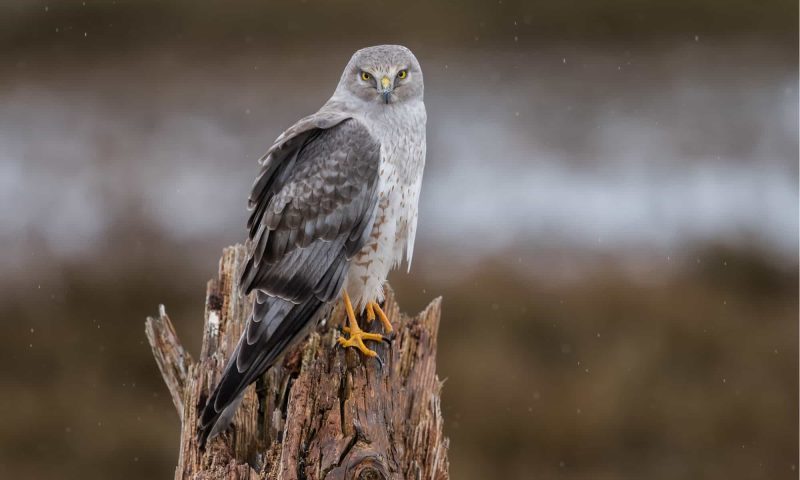
The Northern Harrier is a slender, long-winged hawk with a wingspan of 40 to 46 inches and a length between 18 to 20 inches. It’s one of the few hawks with a facial disk similar to that of an owl, helping it detect prey by sound as well as sight. Males are pale gray above with white underparts, while females and juveniles are brown with streaked undersides. All have a distinct white rump patch, easily visible during flight.
This hawk’s flight is graceful and buoyant, often seen gliding low over meadows and marshes in search of small mammals and ground-nesting birds. It hunts by listening for rustling movements, a technique uncommon among hawks. Northern Harriers often fly with their wings held in a shallow “V,” occasionally hovering before dropping onto prey.
Breeding pairs build nests on the ground, concealed in tall grasses or reeds, and share parental duties. During courtship, males perform spectacular aerial displays, twisting and looping through the sky. They are solitary hunters outside of the breeding season but may roost communally during migration and winter.
In New Hampshire, Northern Harriers are summer breeders in open wetlands and fields, particularly in the Seacoast region, Great Bay area, and Connecticut River Valley. They migrate southward in late fall, though a few individuals may linger through mild winters along coastal marshes and inland valleys.
Broad-winged Hawk (Buteo platypterus)
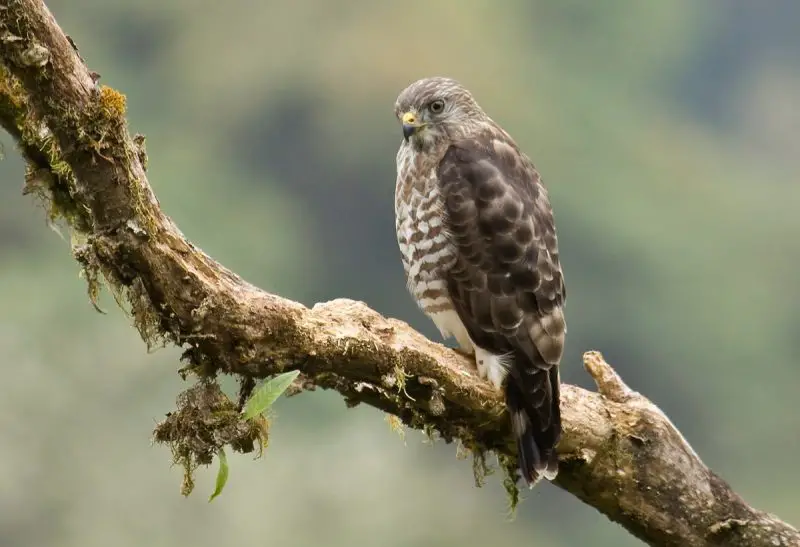
The Broad-winged Hawk is a compact raptor, measuring 13 to 17 inches long with a wingspan of around 32 to 39 inches. Its broad wings and short tail give it a sturdy, stocky appearance. Adults are brown above with barred underparts and a prominent black-and-white tail band, while juveniles show lighter streaking and less distinct markings.
These hawks prefer deciduous or mixed forests near water, often nesting in tall trees under dense canopy cover. They build their nests high above the ground using sticks, leaves, and bark, returning to the same area year after year. Their diet consists mainly of small mammals, amphibians, and insects — particularly frogs, snakes, and large grasshoppers.
One of the most remarkable features of this species is its migration behavior. In late summer, thousands of Broad-winged Hawks form large flocks known as “kettles”, spiraling high into the air as they ride thermals southward toward Central and South America. This phenomenon makes them a favorite among birdwatchers at hawk migration sites.
In New Hampshire, Broad-winged Hawks are common summer residents, breeding throughout the White Mountains, Monadnock region, and northern hardwood forests. They leave the state by September, joining massive southbound migrations that pass over raptor observatories such as Carter Hill and Pack Monadnock.
Northern Goshawk (Accipiter gentilis)
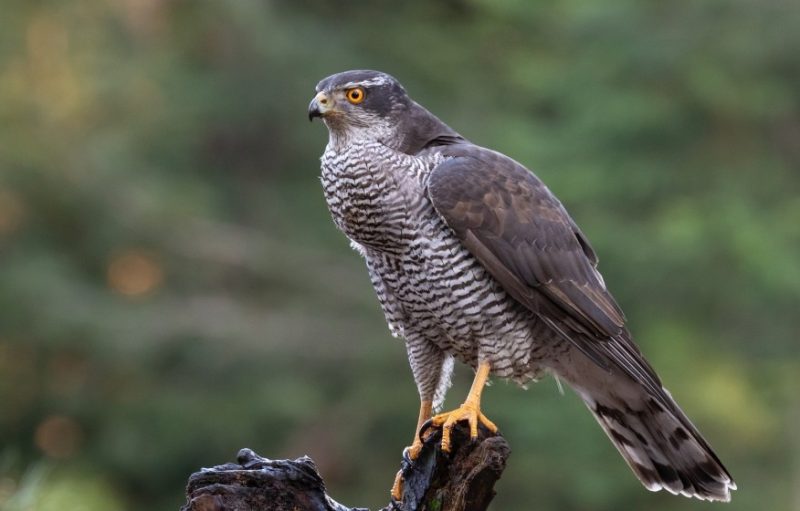
The Northern Goshawk is the largest accipiter in New Hampshire and a formidable forest hunter. Adults measure 20 to 26 inches long with a wingspan reaching 40 to 46 inches. They have slate-gray upperparts, finely barred underparts, and a bold white eyebrow stripe that gives them a fierce expression. Their deep red eyes and long, broad tail complete their striking look. Juveniles are brown with streaked chests and yellow eyes that darken as they mature.
These hawks are known for their strength, agility, and aggressive nature, especially during nesting season. They hunt a wide range of prey — from squirrels and rabbits to grouse and crows — using explosive bursts of speed through dense woods. Northern Goshawks are extremely territorial and will not hesitate to defend their nests from intruders, including humans, with dramatic dive-bombing attacks.
Breeding pairs often occupy large tracts of mature coniferous or mixed forest, building bulky stick nests high in trees. They return to the same nesting territory each year, often alternating between several old nests within their range. Their call — a harsh “kak-kak-kak” — echoes through the forest during spring courtship.
In New Hampshire, Northern Goshawks are year-round residents, though they are most common in the northern and central regions, particularly around the White Mountain National Forest. Their elusive nature makes sightings rare, but careful observers in mature woodlands may occasionally spot one gliding silently between trees or perched on a forest edge scanning for prey.
Rough-legged Hawk (Buteo lagopus)
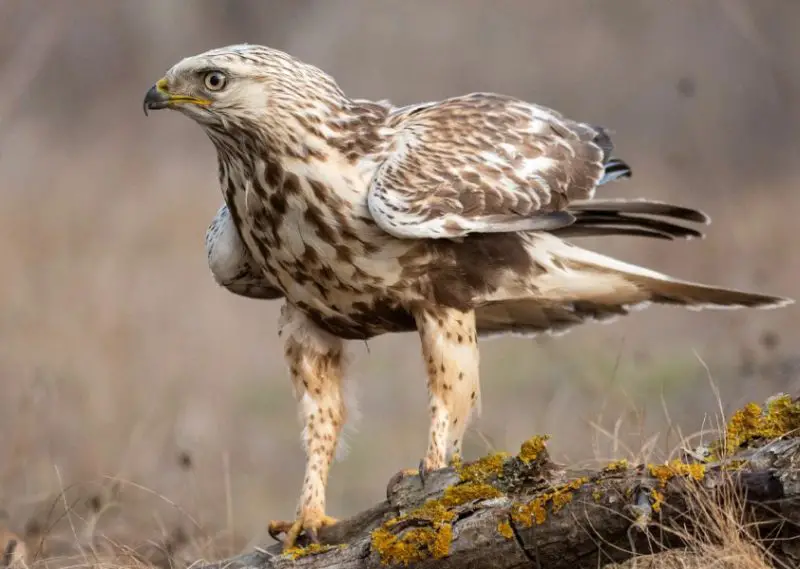
The Rough-legged Hawk is a winter visitor to New Hampshire, arriving from the Arctic tundra where it breeds. It measures 18 to 24 inches in length, with an impressive wingspan between 48 and 56 inches. Its feathered legs — an adaptation to frigid climates — give the species its name. Rough-legged Hawks occur in both light and dark morphs, but all forms show a broad dark band across the belly and a distinctive tail pattern with a white base and dark terminal band.
These hawks are often seen hovering in place with their wings beating steadily against the wind — a rare behavior among large hawks. Their hunting style involves scanning open fields, marshes, and coastal plains for small mammals such as voles and lemmings. They have a calm temperament and often perch on fence posts or isolated trees, carefully watching for movement below.
Rough-legged Hawks are migratory, spending their summers breeding in Arctic regions and traveling south to New England for the winter. Their diet shifts slightly depending on prey availability, and they are known to scavenge during harsh weather when live prey is scarce. Despite their size, they are light and buoyant fliers, gliding effortlessly on long wings.
In New Hampshire, these hawks appear mainly from November through March, favoring open agricultural fields and coastal marshlands. Good observation areas include the Seacoast, Great Bay National Wildlife Refuge, and Connecticut River Valley, where they can sometimes be seen perched motionless against the snowy landscape, blending perfectly with the winter scenery.
Red-shouldered Hawk (Buteo lineatus)
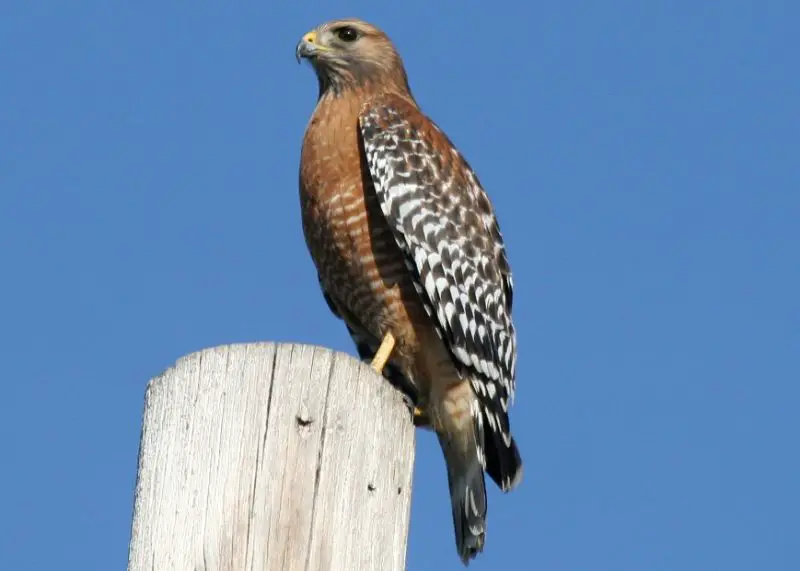
The Red-shouldered Hawk is a medium-sized forest raptor recognized for its bold plumage and loud, repetitive “kee-aah” call. Measuring 16 to 24 inches long with a wingspan of 37 to 43 inches, it has reddish-brown shoulders, black-and-white checkered wings, and a barred reddish chest. Its tail shows narrow white bands and a dark tip. These markings make it one of the most visually striking hawks in New England.
This species prefers moist deciduous woodlands, particularly near rivers, swamps, and forested wetlands. It perches quietly within the canopy, waiting to ambush frogs, snakes, lizards, or small mammals moving below. Its hunting style involves short bursts of flight and sudden dives through the trees. During breeding season, pairs often reuse the same nest, building it high in oaks or maples near water.
Red-shouldered Hawks are highly vocal, especially in spring when defending their territory. They are also more tolerant of human presence than some other woodland raptors and may nest in suburban areas with tall trees and nearby ponds. Their call is so distinctive that it is often heard long before the bird is seen.
In New Hampshire, Red-shouldered Hawks are most common in the southern and central parts of the state, particularly around Lake Winnipesaukee, the Merrimack Valley, and Connecticut River floodplain forests. They are year-round residents in milder regions but may migrate southward during severe winters, returning in early spring to establish breeding territories.
Osprey (Pandion haliaetus)
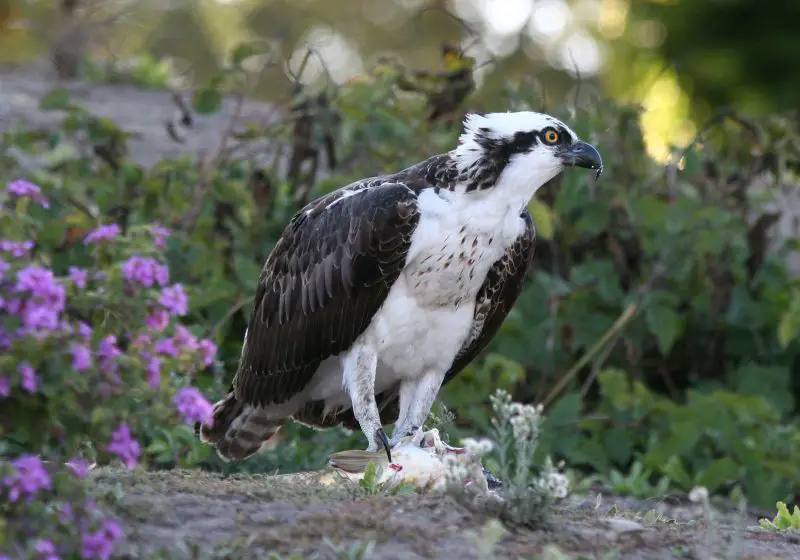
Although technically a “fish hawk,” the Osprey is frequently grouped with hawks due to its behavior and raptor-like characteristics. It measures 21 to 24 inches in length, with a wingspan of about 59 to 70 inches. The Osprey has long, narrow wings that bend at the “wrist” and a white underside with a dark eye stripe extending from the beak to the back of the head. Its hooked talons and reversible outer toe are perfectly adapted for gripping slippery fish.
Ospreys are expert anglers, diving feet-first into the water to catch fish — their primary food source. They can be seen hovering briefly above lakes and rivers before plunging downward with remarkable precision. Once they secure a catch, they orient the fish headfirst to reduce drag as they fly back to their nesting site.
They build large stick nests on elevated structures such as dead trees, utility poles, or specially constructed platforms. Ospreys are loyal to their nesting territories and often return to the same site year after year. Their populations in New Hampshire have rebounded in recent decades thanks to conservation efforts and the reduction of harmful pesticides like DDT.
In New Hampshire, Ospreys are summer breeders, commonly found around Lake Umbagog, Great Bay Estuary, and Lakes Region. They arrive in April and depart by late September for their wintering grounds in the Caribbean and South America. Their distinctive, high-pitched whistles are a familiar sound along the state’s waterways during warmer months.
Swainson’s Hawk (Buteo swainsoni)
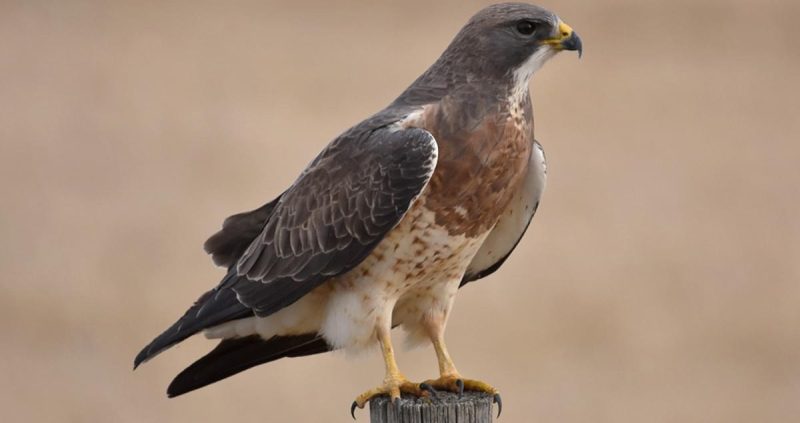
The Swainson’s Hawk is a rare and occasional visitor to New Hampshire, typically sighted during migration. It is a slender, long-winged hawk measuring 18 to 22 inches long with a wingspan of about 46 to 54 inches. Adults have brown upperparts, a contrasting white belly, and a dark bib across the chest. In flight, they show pointed wings and a dark trailing edge that helps distinguish them from similar species.
Unlike many other hawks, the Swainson’s Hawk is primarily an open-country raptor, favoring grasslands, prairies, and agricultural fields. Its diet changes seasonally — during breeding, it feeds on small mammals and birds, while during migration, it consumes large numbers of insects, particularly grasshoppers and dragonflies. This flexibility helps sustain it during its long migratory journeys.
Swainson’s Hawks are famous for their incredible migrations, traveling up to 14,000 miles annually between North America and their wintering grounds in Argentina. During these journeys, they often join massive flocks of hundreds or thousands of individuals soaring on thermals, a breathtaking sight for birdwatchers lucky enough to witness it.
In New Hampshire, Swainson’s Hawks are considered accidental visitors, occasionally appearing during fall migration when strong weather systems push them off their typical western route. Most recorded sightings have occurred in the southern parts of the state, near Concord and Seacoast birding areas, where they may briefly rest before continuing their journey southward.
Tips for Observing and Photographing Hawks in New Hampshire
Best Time of Year for Hawk Watching
The most rewarding periods to observe hawks in New Hampshire are during the spring and fall migrations, when raptors travel along predictable flyways. From late March through May, hawks return north to breed, while September and October bring spectacular southward migrations. The Pack Monadnock Raptor Observatory and Carter Hill Orchard in Concord are premier locations to witness hundreds, sometimes thousands, of hawks gliding overhead on clear, breezy days.
Early morning and late afternoon offer the best viewing conditions as hawks ride thermals that form when sunlight warms the air. Bring binoculars or a spotting scope and scan the skies for silhouettes — the differences in wing shape and flight behavior help identify each species.
Ideal Locations and Habitats
Hawks are found throughout New Hampshire, from coastal marshes and river valleys to mountain ridges and forest edges. Open landscapes like Great Bay National Wildlife Refuge, Merrimack River Valley, and Lake Umbagog National Wildlife Refuge provide excellent chances to see Red-tailed Hawks, Northern Harriers, and Ospreys. In contrast, dense forests and mixed woodlands in White Mountain National Forest are better suited for spotting elusive Northern Goshawks and Cooper’s Hawks.
When visiting these areas, keep movement slow and avoid sudden noises. Hawks are highly alert and can detect human presence quickly, especially during nesting season. Observing from a distance with a telephoto lens or binoculars ensures both great viewing and minimal disturbance to the birds.
Techniques for Photographing Hawks
Photographing hawks requires patience and timing. Start by understanding their hunting and flight habits — Red-tailed Hawks often perch near open fields, while Northern Harriers fly low over grasslands. For perched birds, maintain a respectful distance and use a 300mm or longer lens to capture sharp, detailed shots. Morning light is ideal, as it adds warmth to plumage colors and reduces harsh shadows.
For in-flight photography, use fast shutter speeds (1/2000s or faster) to freeze wing motion. Continuous autofocus and burst mode help capture multiple frames as the hawk soars or dives. Position yourself with the sun behind you, allowing natural illumination on the bird’s underside. When possible, photograph from an elevated position — cliffs, observation towers, or hills — to achieve eye-level perspectives with hawks in flight.
Ethical Birdwatching Practices
Always prioritize the welfare of wildlife over getting a perfect shot. Avoid approaching nests or disturbing resting hawks, as stress can cause them to abandon feeding or nesting areas. Follow Leave No Trace principles, stay on established trails, and respect private property boundaries.
If you observe unusual behavior, such as aggressive swooping or alarm calls, back away immediately — this indicates proximity to a nest. Reporting rare species, like the Northern Goshawk or Swainson’s Hawk, to local birding organizations or NH Audubon helps with state conservation efforts. Responsible observation ensures future generations can continue enjoying New Hampshire’s incredible raptor populations.
FAQs About Hawks in New Hampshire
What is the most common hawk species in New Hampshire?
The Red-tailed Hawk (Buteo jamaicensis) is the most common and widespread hawk in New Hampshire. It can be seen year-round perched along highways, in open farmlands, or soaring high over forest clearings. Its broad wings and red tail make it unmistakable even from a distance.
Do hawks stay in New Hampshire during the winter?
Yes, several species remain in the state through winter. Red-tailed Hawks, Cooper’s Hawks, and Northern Goshawks are year-round residents, while Rough-legged Hawks migrate south from the Arctic to spend winters in open farmlands and marshes of New Hampshire.
Where are the best places to see hawk migration in New Hampshire?
The top hawk-watching sites include Pack Monadnock Raptor Observatory in Peterborough and Carter Hill Orchard in Concord. Both locations provide elevated views of migrating raptors during fall. On favorable wind days, birders may spot thousands of Broad-winged Hawks, Sharp-shinned Hawks, and Ospreys gliding overhead.
How can you tell the difference between a Red-tailed Hawk and a Red-shouldered Hawk?
While both species share reddish tones, the Red-tailed Hawk has a broader build, pale underside with a dark belly band, and a solid reddish tail. The Red-shouldered Hawk is smaller, with rich reddish barring on the chest and distinct checkered black-and-white wings. Their calls also differ — Red-shouldered Hawks have a sharp, repetitive “kee-aah” call.
Are hawks dangerous to pets or people?
Hawks generally avoid humans and rarely pose threats to pets. While they occasionally prey on very small animals like rodents or birds, attacks on cats or small dogs are extremely uncommon. Northern Goshawks, however, may act defensively near nests if they feel threatened, so it’s wise to keep distance during breeding season.
Are hawks protected in New Hampshire?
Yes. All hawk species in New Hampshire are protected under the Migratory Bird Treaty Act, which makes it illegal to harm, capture, or disturb them or their nests. Conservation efforts and legal protections have helped populations recover from historical declines caused by habitat loss and pesticide use.
What kind of hawks can be seen along the coast?
Coastal New Hampshire, particularly around Great Bay and Odiorne Point State Park, hosts Northern Harriers, Ospreys, and Rough-legged Hawks. These areas provide open fields and marshlands rich in prey, attracting hawks especially during migration and winter.
Can I attract hawks to my property?
While hawks are wild predators and should not be deliberately attracted, maintaining a natural landscape with tall trees and open areas can make your property hawk-friendly. They are often drawn to areas where songbirds and small mammals thrive, so creating a balanced, native habitat supports the local ecosystem naturally.

